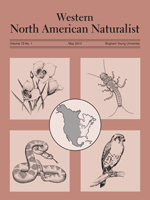Members of the Artemisia tridentata complex (ASTERACEAE; Anthemideae: Artemisia subgen. Tridentatae) have adapted to changing environmental conditions through geographic migration, introgression, and hybridization. These processes have resulted in morphologic and genetic variation. A presumed hybrid (“Bonneville” big sagebrush) of the complex occurs in the moister ranges of A. t. ssp. wyomingensis and can be found growing with shrub species commonly associated with A. t. ssp. vaseyana. These populations appear to be preferred habitat for sage-grouse and are more heavily grazed by ungulates than the parental populations. We determined ploidy levels and conducted a detailed morphological analysis to determine if “Bonneville” is a hybrid entity. Sixteen populations (12 in Oneida Co., ID, and 4 in Rich Co., UT) were selected for the study, representing the putative hybrid (Taxon B) and the putative parents— A. t. ssp. vaseyana (2n = 18), A. t. ssp. wyomingensis (2n = 36), and A. t. ssp. tridentata (2n = 36). Each population consisted of 25 randomly selected individuals for a total of 400 samples. Our analysis showed 3 populations with morphological and chemical characteristics indicating introgression of A. t. ssp. wyomingensis with populations containing A. t. ssp. vaseyana. Based on these results, we designate the Bonneville sagebrush with formal hybrid status of nothotaxon: Artemisia tridentata ssp. × bonnevillensis H. Garrison, L. Shultz, and E.D. McArthur [pro subsp.], 2n = 36.
How to translate text using browser tools
1 May 2013
Studies of a New Hybrid Taxon in the Artemisia tridentata (Asteraceae: Anthemideae) Complex
Heather D. Garrison,
Leila M. Shultz,
E. Durant McArthur
ACCESS THE FULL ARTICLE

Western North American Naturalist
Vol. 73 • No. 1
May 2013
Vol. 73 • No. 1
May 2013




